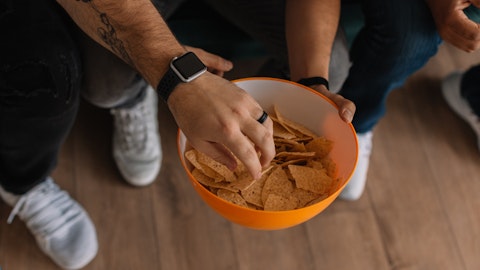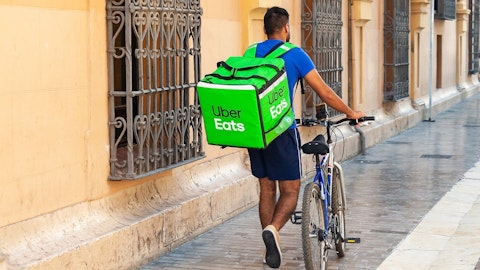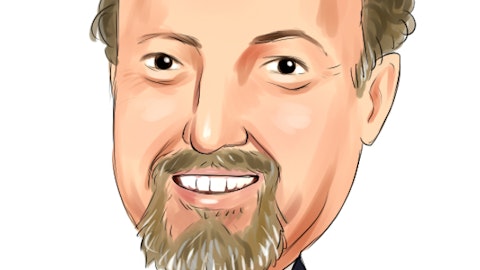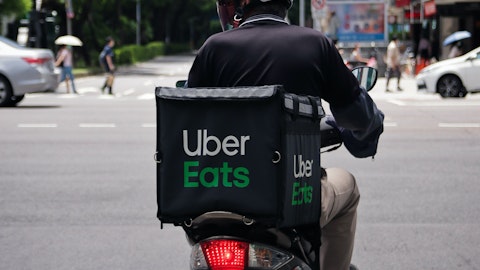DoorDash, Inc. (NYSE:DASH) Q3 2023 Earnings Call Transcript November 1, 2023
DoorDash, Inc. beats earnings expectations. Reported EPS is $-0.19, expectations were $-0.45.
Operator: Thank you for standing by, and welcome to the DoorDash Q3 2023 Earnings Call. I would now like to welcome Andy Hargreaves, VP of Investor Relations to begin the call. Andy, over to you.
Andy Hargreaves: Thank you very much. Good afternoon, everybody, and thanks for joining us for our Q3 2023 earnings call. I am very pleased to be joined today by Co-Founder, Chair and CEO, Tony Xu; and CFO, Ravi Inukonda. We will be making forward-looking statements during today’s call being our expectations for our business, financial position, operating performance, our guidance, strategies, our investment approach, and the consumer spending environment. Forward-looking statements are subject to risks and uncertainties that could cause actual results to differ materially from those described. Many of these uncertainties and risks are described in our SEC filings, including Form 10-Ks and 10-Qs. You should not rely on our forward-looking statements as predictions of future events.

Photo by Brett Jordan on Unsplash
We disclaim any obligation to update any forward-looking statements, except as required by law. During this call, we will discuss certain non-GAAP financial measures. Information regarding our non-GAAP financial measures, including a reconciliation of such non-GAAP measures to the most directly comparable GAAP financial measures may be found in our earnings release, which is available on our Investor Relations website. These non-GAAP measures should be considered in addition to our GAAP results and are not intended to be a substitute for our GAAP results. Finally, this call is being audio webcasted on our Investor Relations website. And an audio replay of the call will be available on our website shortly after the call ends. Operator, I will pass it back to you and we will begin taking questions.
Operator: [Operator Instructions] Our first question comes from the line of Nikhil Devnani with Bernstein. Please go ahead.
See also 11 Best Organic Food and Farming Stocks To Buy and 12 Best Internet of Things (IoT) Stocks To Buy.
Q&A Session
Follow Doordash Inc. (NYSE:DASH)
Follow Doordash Inc. (NYSE:DASH)
Nikhil Devnani: Hey, guys. Thank you for taking my question. I had a two-parter on the U.S marketplace. So everyone is obviously worried about a variety of headwinds and a softening consumer, yet your business is accelerating in the U.S. Can you comment on, one, what drove that acceleration? And then as a follow-on, I think the perception is your marketplace is highly discretionary, but given all the data you see in how consumers actually use your service, would you agree with that assessment? And how do you think about the sensitivity of demand?
Tony Xu: Hi, Nikhil, it’s Tony. Maybe I’ll start and Ravi, feel free to chime in. On the first part of the question, I mean you’re absolutely right. I think we saw a phenomenal quarter where frankly, every line of business has accelerated in growth and improved in its unit economics. And that’s impressive, especially given the fact that we’re a lot larger today than we were a quarter ago and certainly a year ago. In terms of the U.S. restaurant business or the marketplace in general, I mean, a few phenomenon are going on, but really it’s the result of product improvements we’ve made. Whether you look a quarter ago or a year ago, we’ve added selection to the platform on the restaurant side, and we’ve added a lot of selection on the non-restaurants front, literally going from 0 nearly 3 years ago to a multibillion-dollar business that’s at scale now growing fast and contributing quite significantly.
And we have over 100,000 stores on the platform that are outside of restaurants. And when you look outside of restaurants and into the convenience or grocery or alcohol segments, almost half of new customers that come into the industry in the U.S. come to DoorDash first. And so that’s certainly adding in terms of the selection. Second, we’ve continued to improve the quality of service, whether it’s our timeliness, our speed, our accuracy. Third, we’ve improved the affordability of the programs, both for our non-DashPass members as well as for our DashPass cohorts. And fourth, we’ve improved customer support all along the way. And so it’s really the result of many years of work on the fundamentals and mastery of that and continuing to see opportunities to continue improving the product, both in terms of efficiencies and just product quality to the customer that’s leading to the growth of all of the lines of business in the U.S., and that’s what you kind of saw culminate in some of the numbers that we reported in Q3.
I think with respect to the second question, it’s — I think we’ve — our business has always been very dynamic in terms of all of the headwinds and tailwinds it’s faced in the 10 years that we’ve been building DoorDash. And that’s certainly been true in the last 3 years. Obviously, we lived through a global pandemic. We lived through peak pandemic. We have lived through peak inflation. We’ve lived through lots of other macro factors, including some of the ones impacting us today. And I think it’s important to remind ourselves of a few things. While it’s virtually impossible to estimate or isolate the quantum impact of any one of these macro factors, I think it’s a lot easier to think about things that we do control. And as mentioned in the answer to the previous question, we’ve continued to improve our product.
And that’s certainly within our control and as dynamic, if not more dynamic, than some of the macro changes that we face. I think, second, we benefit from the fact that our first category, the restaurants category, stems in the sense that while sure, maybe not every meal has to be eaten when it comes to delivery or takeout, but when you think about every category that lends itself towards convenience, and we all know that convenience only lends itself towards the direction of greater convenience. Food is the most resilient and highest frequency category. I mean, this is true in every line of eCommerce. In fact, if you look at our cohort performance, which we talked a little bit about in our shareholder letter this quarter, you see that virtually every single cohort, including those that just joined our platform a couple of months ago are doing way better than any of the cohorts even during the pandemic.
And so I think as you see that behavior across every line of — every segment of customers every cohort across time, I think you start to gain a different picture of just the fact of the product improvements as well as the number of shots on goal that we get to take relative to others in capturing that customer. And the final comment I’d make is, in spite of our performance and our market leadership, we are still a tiny fraction of what’s addressable. I mean in the U.S. restaurants category, as 1 example, we are less than double-digit percentage sales of the industry. I think you looked globally within restaurants, we are a much tinier single-digit percentage. And if we included all the other categories that we now entered, we are barely noticeable.
And so I think we have a long runway left. We have a lot more work to do to get our product to where we would like it to be. But I think the product improvements that we’ve made in the years leading up to these moments have certainly helped us build a product that endures.
Nikhil Devnani: Thanks, Tony.
Operator: Our next question comes from the line of Ross Sandler with Barclays. Please go ahead.
Ross Sandler: Hey, guys. If I can ask three quick ones, that would be great. First, Tony, on the international footprint. We are now into — well past the year into the Wolt integration. How do you feel about that? And are there any geographies that you think might be interesting from an M&A perspective in the future for international? Second question is we keep getting this one a lot from the investment community. Maybe you guys can clearly the air on the GLP-1 diet drugs. Is there any way to think about how that might impact your business in the future? It’s obviously not impacting it now. And then lastly, Instacart is now, there is a public company. Just curious to get any milestones on grocery GOV as we sit here at the end of ’23 from you guys? Thanks a lot.
Tony Xu: Great. Hey, Ross. I’ll do my best to take them the first two in order and maybe I’ll let Ravi take the third one. So I think the first question was around international. I mean you’re absolutely right. We are very excited about our execution on the international front. We continue to grow at multiples of what we see around the world, virtually across any geography. That doesn’t mean that we are pleased yet with where our product is. We still have a lot of room left to go. But I think it does stem from why our outperformance has occurred, which is I think the hallmarks at any great marketplace have the fundamental characteristics of great retention order frequency and unit economics. And I think when you look at our international business or our new categories business or a restaurant business, you see all of these characteristics present.
And that’s why we’ve been very interested in leaning in and making the investments that we have at size, at scale, because of what we see. And the international business continues to see those points of execution. I think if we remind ourselves even a couple of years ago of the investment thesis behind our partnership with Wolt, it really centered on two big pieces. One of which was here is a business that has leading world-class retention and order frequency, and the question is, can we invest behind that in a concentrated way and hopefully add to the excellent execution that they’ve already seen. And so far, the answer has been yes to that. In fact, Miki and the team now runs our entire portfolio, certainly the Wolt portfolio as well as the DoorDash portfolio outside of the United States.
And the second part of the thesis was that there is a long runway for growth in a lot of these countries, and we continue to see that, too. In the 27 countries outside of the U.S. that we operate in, we are in some ways behind where the U.S. is from a penetration perspective and also product adoption perspective. There just is a lot more population we have to address. There are more merchant partners we’ve yet to partner with. There’s a lot more customer problems given the fact that some of these places are a little bit behind from a technology footprint. And so there’s a lot of work to do, but it also means that there’s a lot of runway ahead. And I think that’s why you’ve seen continued momentum, and it’s adding now to the overall growth of the company.
I think your second question was around some of the recent discussions externally around a certain class of drugs. First and foremost, I hope that they actually work these drugs. As a former scientist, I’m a big believer, whenever a great science can actually meet the challenges of its time and I do think that they’re solving a worthy problem. So first and foremost, for the patients, I hope that they work for the long-term. Second, we don’t see any immediate or noticeable impacts in the business relative to, I guess, what the commentary may be out there about this class of drugs. And I think this kind of goes a little bit to the first question that was asked, which is it’s been really hard to size any one macroeconomic factor, whether it’s a headwind, a tailwind, a side wind.




